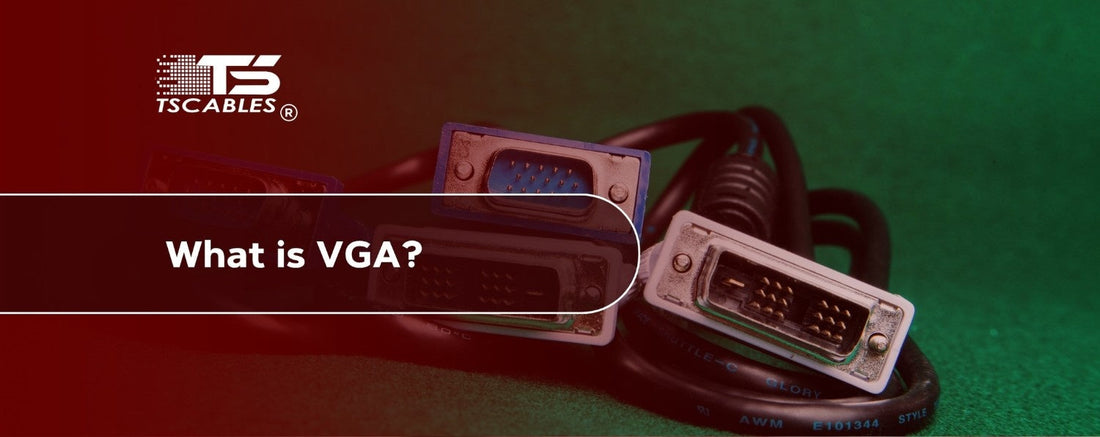You’ve probably seen a blue port on the back of an old computer or monitor. That’s VGA, and it’s been around for decades and still shows up in offices, schools, and older systems. While new tech takes the spotlight, VGA quietly gets the job done for video connections.
This guide explains what a VGA is, how it works, and why it’s still relevant. We’ll keep things simple, short, and clear. It will provide you with everything you need to know to spot it, use it, or replace it with confidence.
What is a VGA?
VGA stands for Video Graphics Array. It’s a display standard developed by IBM in 1987. VGA sends analog signals from a computer to a screen. These signals carry image data like resolution, color, and brightness. You might still find VGA in classrooms, conference rooms, or older desktops.
The VGA cable port has 15 small holes in three rows. It connects to a matching port on your monitor or projector. VGA does not carry sound, only video. While newer options like HDMI and DisplayPort are digital, VGA still works for basic displays and older gear.
Types of VGA
VGA might sound like one thing, but it’s not. Over the years, different versions and cable types have popped up. Each one does the same basic job but might vary in build or signal quality. Understanding the types of VGA can help if you’re sorting through a box of cables or trying to match devices. Here are a few versions you may run into.
Standard VGA (DE-15)
This is the most common version. It has 15 pins and is often colored blue. If you ask about the common use cases, then it’s found on monitors, projectors, and desktops built before 2015.
Mini-VGA
Laptops, especially older Apple and HP models, sometimes use a smaller version called Mini-VGA. It needs an adapter to work with full-size VGA displays.
Super VGA (SVGA)
SVGA offers better resolution than standard VGA. It still uses the same port but is designed to support sharper images that are up to 800x600 or more.
VGA Extension Cables
VGA extension cables don’t change the signal. Instead, they simply make the cable longer. If your screen is too far from your PC, an extension cable bridges the gap.
VGA to HDMI or DVI Adapters
These let you connect a VGA source to a digital display. Keep in mind, VGA is analog. Therefore, adapters must convert the signal, not just change the shape of the plug.
What is a VGA Connector Used For?
Now that you know what VGA is, let’s talk about how it’s used. The VGA jack still appears in lots of places. Some systems rely on it for simple display tasks where high definition isn’t needed. It works quietly behind the scenes in schools, stores, and older media setups. Below are the most common answers to what a VGA connector is used for, from classrooms to control panels.
Connecting Desktops to Monitors
Before HDMI became standard, VGA was the main way to link a PC to a screen. It still works fine for office documents, browsing, or basic software.
Projectors and Presentation Systems
Older projectors rely on VGA for input. You’ll often see teachers plug laptops into classroom projectors using a VGA cable for easy screen sharing.
POS Systems and Cash Registers
Many point-of-sale systems still use VGA. These displays don’t need high resolution, so VGA handles the job without issues.
Surveillance Monitors
Security systems often include a VGA cable port to connect control units to basic screens. It’s stable, simple, and easy to replace if damaged.
Testing and Troubleshooting
Techs still carry VGA cables to test displays. If an HDMI port fails, VGA is a backup option to see if the screen still works.
VGA Symbols and Signals
VGA uses analog signals. This means the image is sent as a wave, not digital code. The downside is that it can pick up interference and isn’t as sharp as digital video. Still, VGA signals work well for many low-res or mid-res tasks.
The VGA symbol is usually a rectangle with a row of dots or pins inside. You might see this icon on ports, cables, or screens. It helps users find the right connection.
If you see static, flickering, or blur, the signal might be weak. Check the pins as they should be straight and unbent. In addition to that, dirty or loose connectors also cause problems.
Wrapping Up
VGA may be old, but it’s far from gone. It still works in offices, classrooms, and older tech setups. Knowing what a VGA is, where it’s used, and how it looks keeps you ready for any job. From the VGA jack to the VGA symbol, it’s all about simple video connections that still hold up.
TS Cables offers reliable VGA cables, adapters, and accessories built to keep your legacy tech running. Browse their full range and find the right fit for your setup today.
FAQs
1. Can VGA carry audio signals?
No. VGA only sends video. You’ll need a separate cable for audio.
2. What devices still use VGA?
Old monitors, projectors, cash registers, and some desktops still have VGA ports.
3. Is VGA better than HDMI?
HDMI offers better quality and sound. VGA is older and analog, but still useful for basic tasks.
4. How do I identify a VGA port?
Look for 15 tiny holes in three rows, often colored blue, or find the VGA symbol near the port.
5. Do VGA cables come in different lengths?
Yes. You can get short ones for tight spaces or longer ones for across-room setups.






